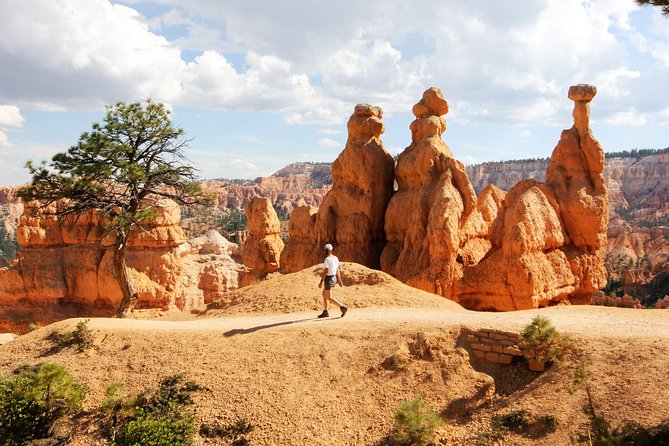Exploring Zion: Trails, Tips, and Best Times to Visit
- makoklu33
- Oct 7, 2024
- 7 min read
Updated: Sep 5
You can easily spend a couple of days in each canyon. On this page, I’ll share my experiences at the locations I visited, as well as some spots I wanted to see but couldn't due to time or weather constraints.
My journey began early on a Saturday in Zion, where I completed two hikes and stayed overnight. The following morning, I enjoyed another hike before heading to Bryce Canyon. At Bryce, I tackled a beautiful loop trail and captured some stunning photos in both canyons.
Zion’s got it all—massive red rock cliffs, epic hikes like Angels Landing and The Narrows, and some seriously jaw-dropping views. It’s a place where desert meets forest, and wildlife and wild beauty are everywhere. People have been connected to this land for thousands of years, and it still inspires adventure, peace, and awe today. Whether you're into hiking, snapping photos, or just soaking up nature, personally Zion’s one of those places I will never forget.

Table of Content
Lets get start with a where to visit in Zion
Angels landing
I think this is one of my favorite hikes from my entire trip: Angels Landing. This hike is a must-do if you’re visiting Zion National Park, but be sure to apply for a permit first. You can get your permit on this page.
The hike is approximately 5 miles round trip with an elevation gain of around 1,488 feet. The trail features a mix of steep switchbacks, known as Walter’s Wiggles, and narrow sections with chains to assist hikers along the final ascent.
Once you reach the top, the view is absolutely breathtaking. You’re rewarded with panoramic vistas of Zion Canyon, including dramatic red rock formations and the winding Virgin River below. If you’re looking for a hike that combines challenge with stunning scenery, Angels Landing is the perfect choice!

Zion canyon road
I highly recommend driving along Zion Canyon Road, which is approximately 7 miles long. It offers stunning views of the park's iconic landscapes, making it a worthwhile experience. However, please note that during the summer months, you cannot drive your personal vehicle on this road; you'll need to use the park's shuttle system instead. You can find more information about the shuttle system on this page.

Canyon Overlook Trail
The Canyon Overlook Trail is a relatively short hike, measuring about 1 mile round trip with an elevation gain of approximately 163 feet. Despite its brief length, this trail rewards hikers with stunning panoramic views of Zion Canyon from the overlook.
As you drive to the trailhead, the road itself—Zion-Mount Carmel Highway—offers spectacular scenery, including sweeping vistas and unique rock formations. The drive is an experience in itself, with several pullouts where you can stop and take in the breathtaking surroundings. These are the highlights from my visit that I highly recommend. One trail I wanted to hike but couldn’t is The Narrows. This unique hike involves wading through the Virgin River, which can be quite deep and cold in winter. The hike is approximately 9.4 miles long if you go all the way to the Temple of Sinawava, with an elevation gain of about 1,200 feet. It’s not the most enjoyable experience during winter, but if you’re visiting in the summer or on a warm day, I definitely recommend it!
There are a couple of other hikes I didn’t get the chance to explore, primarily because they were closed due to snow or because they didn’t appeal to me based on the photos I saw online. Still, I wanted to mention them so you can make your own judgment:
Observation Point: A strenuous but rewarding hike that offers breathtaking views of Zion Canyon from above. It’s about 8 miles round trip with an elevation gain of approximately 2,148 feet.
Weeping Rock: A short and easy trail leading to a beautiful rock alcove with dripping springs. However, it may be closed at times due to rockfall hazards.
Emerald Pools: A series of short hikes that lead to picturesque pools and waterfalls. The trails vary in difficulty, making it a great option for families.
Shuttle System
Peak Season: During the busy season (typically from mid-March to late November), the main canyon road is closed to private vehicles. Instead, visitors must use the park’s shuttle system to access popular areas, including the Zion Canyon Scenic Drive, Angels Landing, and The Narrows.
Shuttle Schedule: The shuttles run frequently and are included with your entrance fee. It’s a good idea to arrive early in the day to secure your spot on the shuttle, especially if you plan to hike Angels Landing.
Off-Peak Season
Winter Months: From late November to early March, you can usually drive your personal vehicle into the canyon, as the shuttle system is not in operation. However, be mindful of weather conditions, as snow and ice can affect road accessibility.
🌤️ Best & Worst Time to Visit Zion National Park (By Month)
If you’re planning your trip, timing makes a huge difference in your experience. Here’s a breakdown month-by-month so you know what to expect:
Month | Avg Temp (°F) | Daylight Hours | Pros | Cons |
January | 54 / 30 | ~10 hrs | Peaceful, fewer crowds, snow-dusted cliffs | Some trails icy/closed, cold nights |
February | 58 / 33 | ~11 hrs | Less busy, good for photos | Still chilly, limited services |
March | 65 / 39 | ~12 hrs | Wildflowers start blooming, shuttle begins mid-month | Variable weather |
April | 73 / 45 | ~13 hrs | Great hiking weather, waterfalls flowing | Crowds increasing |
May | 83 / 54 | ~14 hrs | Warm but manageable temps, long days | Peak crowds begin |
June | 94 / 63 | ~15 hrs | Long days for exploring, shuttle runs often | Extremely hot, crowded trails |
July | 99 / 70 | ~15 hrs | Summer vibes, Narrows hike popular | Very hot, flash flood risk, busiest month |
August | 97 / 68 | ~14 hrs | Narrows still prime, summer evenings are gorgeous | Heat, heavy visitation |
September | 89 / 60 | ~13 hrs | Cooler temps, fall colors start | Still busy early in the month |
October | 78 / 48 | ~11 hrs | Best balance: fewer crowds, mild temps, fall foliage | Shorter days |
November | 64 / 38 | ~10 hrs | Quieter, cheaper stays nearby | Shuttle stops late Nov, colder nights |
December | 53 / 30 | ~9 hrs | Low crowds, magical winter scenery | Limited access, short days |
👉 Best Month to Visit Zion: October — amazing weather, fewer crowds, and beautiful fall colors.
👉 Worst Month to Visit Zion: July — it’s scorching hot, crowded, and prone to flash floods.
🚗 Travel Logistics: How to Get to Zion National Park
Zion is tucked in southwestern Utah, and getting there is easier than you might think.
From Las Vegas (170 miles, ~2.5 hours): The most popular route! Fly into Harry Reid International Airport and drive northeast on I-15. This is the best option for weekend trips.
From Salt Lake City (300 miles, ~4.5 hours): A longer drive but doable. Perfect if you’re combining Zion with Arches, Canyonlands, or Capitol Reef on a Utah road trip.
From St. George, Utah (40 miles, ~1 hour): The closest city with an airport (SGU). Great for regional flights.
Other Airports Nearby:
Cedar City Regional Airport (60 miles, ~1.25 hours)
Flagstaff Pulliam Airport (3.5 hours, good if combining with Grand Canyon)
Pro Tip: If you’re doing a Utah Mighty 5 road trip (Zion, Bryce Canyon, Capitol Reef, Arches, Canyonlands), Las Vegas is usually the cheapest and most convenient starting point.
❓ Zion National Park FAQs: Everything You Need to Know
What is the best month to visit Zion National Park?
October is a top pick! The weather’s cooler, the fall colors pop, and it’s less crowded. Perfect for Utah adventures without the summer heat.
When not to visit Zion National Park?
Try to avoid July—it’s super hot (often 100°F+), the crowds are intense, and summer brings the risk of flash flooding, especially in narrow canyons like The Narrows.
What is the best month to hike The Narrows?
October again wins! The temps are comfy, crowds are smaller, and the water levels are usually just right. Still, check with the visitor center for safety updates before heading out.
What is the water temperature in The Narrows in May?
In May, the water’s pretty chilly—around 50°F. You’ll definitely want layers and maybe a drysuit. Don’t forget to pack plenty of water too!
What is the hottest month in Zion?
July takes the crown. Temps soar over 100°F, so if you’re hiking, bring extra sunscreen, electrolytes, and lots of water.
Is there a better hike than Angels Landing?
Some say Observation Point offers even better views—with fewer crowds and no chains! It’s longer and tougher, but the panoramic views of Zion Canyon are unforgettable.
Is 2 days enough for Zion National Park?
Yep, 2 days is enough to hit the highlights like Angels Landing, Canyon Overlook, or The Narrows. Just plan ahead, stay in Springdale or camp inside the park, and start hikes early.
Should I spend more time in Zion or Bryce Canyon?
Tough call! If you’re into epic canyon hikes and bold red rock scenery, Zion might edge out. Bryce Canyon is more laid-back and famous for its hoodoos. If possible, visit both—they’re only 1.5 hours apart.
Do you need a car to visit Zion?
Not always. If you’re staying in Springdale, you can hop on the free town shuttle and connect directly to the Zion park shuttle. But if you plan to road trip Utah’s Mighty 5, having a car is a big plus.
Can kids hike Angels Landing?
Technically yes, but it’s not recommended for young children. The final stretch is steep, narrow, and exposed with chains. Safer family-friendly hikes include the Riverside Walk, Lower Emerald Pools, and the Canyon Overlook Trail.
Is Zion dog-friendly?
Dogs aren’t allowed on most trails. The exception is the Pa’rus Trail, a 3.5-mile paved path along the Virgin River. Pets are welcome in campgrounds and picnic areas but must stay leashed.
What’s the best sunrise or sunset spot in Zion?
Sunrise: Canyon Overlook Trail — short, accessible, and incredible morning light.
Sunset: Watchman Trail near the visitor center is perfect for golden-hour photos.
Is Zion worth visiting in winter?
Absolutely! The cliffs sometimes get a magical dusting of snow, crowds are almost nonexistent, and you can drive your own car into the main canyon since the shuttles don’t run. Just pack warm layers—mornings and evenings get chilly.





























Comments